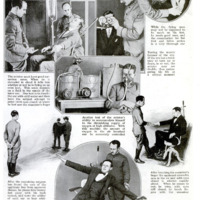The medical tests a person must pass if he wants to become an aviator
Contenuto
-
Titolo
-
The medical tests a person must pass if he wants to become an aviator
-
Article Title and/or Image Caption
-
Tests You Must Go through if You Would Fly for Your Country
-
caption 1: “Probably cighty per cent
of the sick calls on the
other side are made up of
sore throats,” says the
report of the Air Ser
vice Medical. That's
why this aviation candi.
date is being examined
0 thoroughly for ade.
noids and diseased tonsils
caption 2: When one eye is shaded |
from the light and the
other is covered and un-
covered rapidly, the pupil
of the eye that is shaded
will dilate and then con-
tract about as the un.
covered eve does—that |
is, it will if the eves
have normal connection |
between the fibers of |
the two optic nerves
caption 3: The aviator must be a good
judge of distance. If he
isn't he will not be able to
tell the arrangement of an
enemy formation or land
safely at high speed. Here he
is being tested for stercoscopic
vision. If he has it he is prob-
ably a good judge of distance
caption 4: How much can you sce
without turning your
head? To determine
this, theaviation candi-
date is asked to fix his
uncovered eye on the
white spot in the cen-
ter of the perimeter, as
the machine is called,
and, without removing
his gaze from this spot,
to indicate when he
sees another spot move
into the field of vision
caption 5: Of one hundred fliers only sixty-one can work at an alti-
tude of more than 20,000 fect. The rebreathing machine
determines precisely the altitude at which the flier will fail
caption 6: While the flying man
may not be supposed to
be much on his fect,
he needs good ones, and
the examination for flat
foot and fallen arches
is a very thorough one
caption 7: Testing the muscle
balance of the eye.
If the eye has a tend-
ency to tum up or
down, in or out, the
aviater may see
double, thus endan-
gering his life at
a critical moment
caption 8: The aviator must have good ear-
motion sense. When he is
shrouded in cloud it tells him
whether or not he is flying on an
even keel. This sense depends
on a fluid in the canals of the
inner ear. One test is to douch=
the ear with cold water and then
have the subject attempt to
point (with eyes closed) at where
he last saw the examiner's finger
caption 9: Another test of the aviator's
ability to accommodate himself
to the diminishing supply of
oxygen at high altitudes. With
this machine the amount of
oxygen in the air breathed
can be accurately controlled
caption 10: After the examining surgeon
has found the ears of the
applicant free from apparent
disease, he places him twenty
fect away with his back
turned, and tests the ability
of cach car to hear whis-
pered numbers and words
caption 11: After touching the examiner's
finger the applicant raises his
arm in the air and with eyes
closed is whirled rapidly
about. When he comes to
rest, he tries, with eyes
still closed, to. touch fin-
gers with the examiner
caption 12: With eyes closed, the appli-
cant is whirled to the left five
times in ten seconds. If he
is normal he will, when the
chair comes toa stop, feel that
he is falling to the right, and
in trying to overcome it he
will actually fall to the left
caption 13: Testing the peychological effects on the aviator |
of lack of oxygen, to determine how cfficient
he will be when he is flying at high altitudes
-
Lingua
-
eng
-
Data di rilascio
-
1919-08
-
pagine
-
58-59
-
Diritti
-
Public domain (Google digitized)
-
Archived by
-
Davide Donà
-
Alberto Bordignon (Supervisor)



